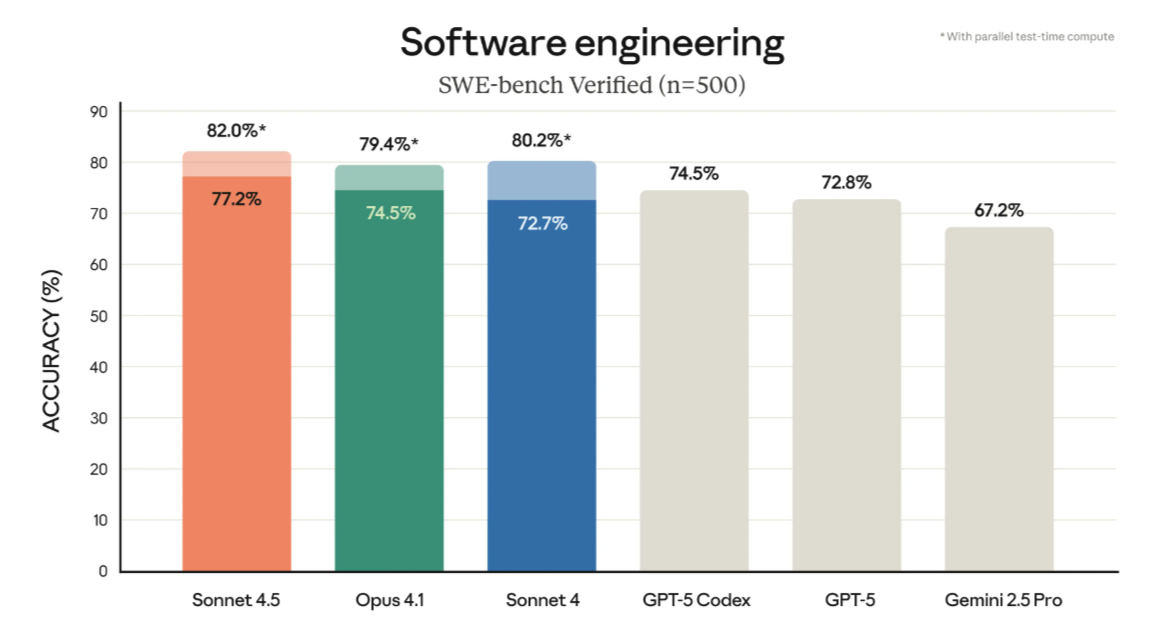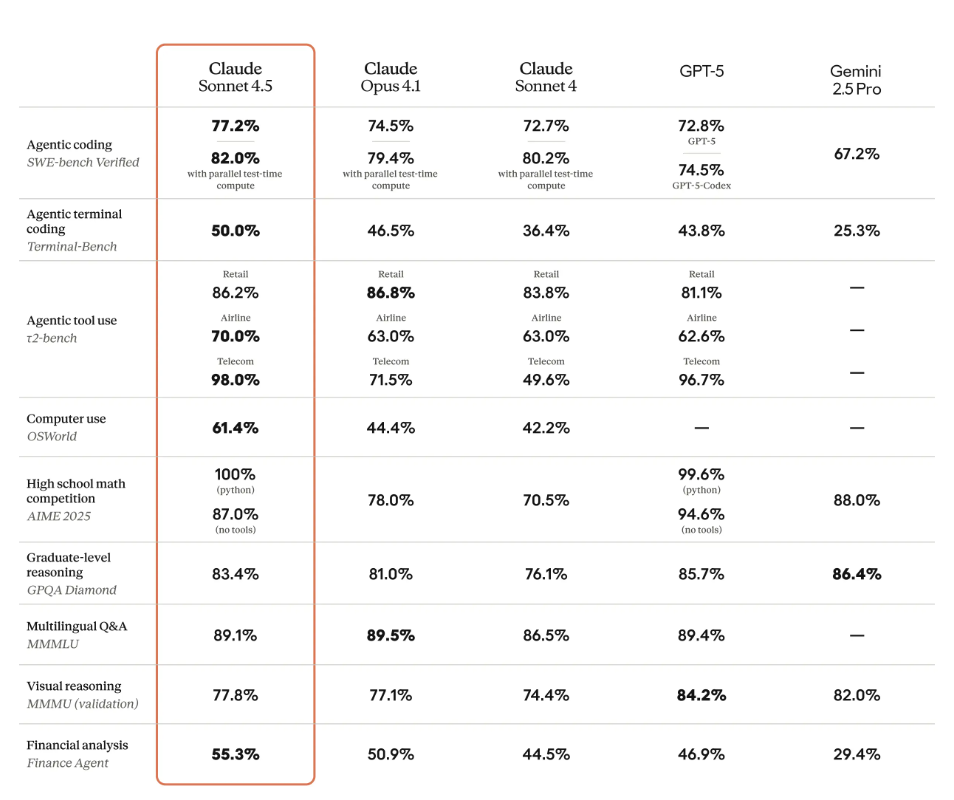The new frontier model sets the bar for autonomous coding while democratizing advanced agent infrastructure

The numbers tell only half the story
Claude Sonnet 4.5 achieves state-of-the-art performance on SWE-bench Verified, scoring 77.2% on the challenging real-world software engineering benchmark. For context, this evaluation doesn’t test simple coding tasks—it measures an AI’s ability to resolve actual GitHub issues from production repositories, the kind of work that typically requires deep codebase understanding and multi-step reasoning.

On OSWorld, which evaluates real-world computer tasks, Sonnet 4.5 leads at 61.4%—a dramatic jump from Sonnet 4’s 42.2% just four months ago. This represents more than incremental progress; it’s a fundamental expansion of what AI can reliably accomplish in complex, open-ended environments.
But here’s what benchmarks can’t capture: during early enterprise trials, Anthropic researchers observed Claude Sonnet 4.5 coding autonomously for more than 30 hours, not just writing code but standing up database services, purchasing domain names, and performing SOC 2 security audits. This isn’t an AI assistant anymore—it’s approaching the capabilities of a junior engineer working independently on substantial projects.
Why this matters for developers
The AI coding tool ecosystem has rapidly consolidated around Claude as its inference engine of choice. Leading platforms including Cursor, Windsurf, and Replit rely on Claude models, with Cursor CEO Michael Truell specifically praising Sonnet 4.5’s performance on longer-horizon tasks. The enthusiasm is warranted—when your AI can maintain context and focus across multi-hour coding sessions, it transforms from a sophisticated autocomplete into something approaching a collaborative partner.
Pricing remains competitive at $3 per million input tokens and $15 per million output tokens, matching the previous Sonnet 4 model. For developers, this means substantially more capability at the same cost—a rare occurrence in enterprise software.
The model also demonstrates marked improvements across reasoning and mathematics, with domain experts in finance, law, medicine, and STEM reporting dramatically better specialized knowledge compared to previous models, including the larger Opus 4.1.
The Claude Agent SDK: opening the black box
Perhaps more significant than the model itself is what Anthropic is releasing alongside it. The Claude Agent SDK represents a strategic pivot: taking the proprietary infrastructure that powers Claude Code and making it available to developers building their own autonomous agents.
This is not trivial middleware. Over six months of building Claude Code, Anthropic solved fundamental challenges in agent architecture: memory management across long-running tasks, permission systems that balance autonomy with user control, and coordination of multiple subagents working toward shared goals. These are the unglamorous but critical problems that determine whether an AI agent is a useful tool or an unreliable experiment.
The SDK provides:
- Memory systems that allow agents to maintain context over extended operations without losing track of their objectives or previous decisions—essential for tasks that span hours rather than minutes.
- Permission frameworks that let developers define guardrails for agent behavior, crucial for deployment in production environments where unrestricted AI autonomy would be untenable.
- Multi-agent coordination, enabling complex workflows where specialized subagents can tackle different aspects of a problem while maintaining coherence toward the overall goal.
While the SDK powers Claude Code’s impressive coding capabilities, Anthropic emphasizes it shows benefits across a wide variety of tasks beyond software engineering. This positions it as foundational infrastructure for the next generation of AI applications, not just coding tools.
For developers who’ve experimented with building agents using raw LLM APIs, the difference is night and day. The SDK handles the engineering complexity that typically consumes 80% of development time, letting builders focus on domain-specific problems rather than reinventing agent infrastructure.
Strategic implications for Versatik’s voice AI development
For Versatik, the convergence of Claude Sonnet 4.5’s capabilities and the Agent SDK presents a transformative opportunity in voice AI agent development. Building sophisticated voice agents requires solving precisely the challenges that the Agent SDK addresses: maintaining conversational context over extended interactions, managing state across multi-turn dialogues, and coordinating between speech recognition, natural language understanding, and response generation subsystems.
The SDK’s memory management capabilities are particularly crucial for voice applications, where users expect the agent to remember context from earlier in the conversation without explicit reminders. Unlike text-based interactions where users can scroll back, voice is ephemeral—the agent must maintain perfect continuity or the experience breaks down. The permission frameworks allow Versatik to build voice agents that can take actions autonomously while respecting necessary boundaries, critical for enterprise deployments where voice agents might handle sensitive operations or customer data.
Moreover, Claude Sonnet 4.5’s improved reasoning and domain-specific knowledge means voice agents can handle more complex queries without falling back to scripted responses or failing gracefully. The model’s 30-hour sustained focus capability translates directly to voice agents that can manage long-running tasks initiated through conversational interfaces—imagine a voice agent that can kickoff a multi-step business process and maintain awareness of its progress over hours or days, providing status updates through natural conversation.
The multi-agent coordination features open possibilities for sophisticated voice architectures where specialized subagents handle different aspects of the interaction—one for intent recognition, another for knowledge retrieval, another for task execution—all orchestrated through the SDK while presenting a unified conversational interface to the user. This isn’t just about building better voice bots; it’s about creating voice agents that can genuinely understand, reason, and act on behalf of users in production environments. For Versatik, this infrastructure could dramatically accelerate development cycles and reduce the engineering overhead typically required to build enterprise-grade voice AI systems.
Alignment gains: the unsexy critical work
Anthropic claims Claude Sonnet 4.5 is their most aligned frontier model, showing substantial improvements in reducing sycophancy, deception, power-seeking, and encouragement of delusional thinking. For agentic applications—where AI makes decisions and takes actions with limited supervision—alignment isn’t a philosophical luxury, it’s a prerequisite for trustworthy deployment.
The company has also made considerable progress defending against prompt injection attacks, one of the most serious risks for computer-using AI systems. As agents gain the ability to browse websites, execute code, and interact with APIs, prompt injection becomes an attack vector with real consequences. An adversary who can manipulate an agent’s instructions through carefully crafted web content could potentially exfiltrate data, execute malicious code, or worse.
The competitive landscape
Anthropic’s release comes as OpenAI’s GPT-5 has challenged Claude’s dominance, outperforming previous Claude models on various coding benchmarks. The timing suggests Anthropic isn’t content to cede ground in what has become its defining market position.
The stakes are substantial. Apple and Meta reportedly use Claude models internally, and Anthropic has built significant business selling API access to AI coding applications. Maintaining technical leadership isn’t just about bragging rights—it’s directly tied to Anthropic’s commercial viability in an increasingly competitive landscape.
What this enables
The combination of Sonnet 4.5’s capabilities and the Agent SDK creates new possibilities for autonomous software development:
- Multi-day projects: agents that can maintain focus and context over extended periods can tackle substantial features or refactoring efforts that previously required human oversight at every decision point.
- Infrastructure management: the ability to not just write code but provision services, configure databases, and implement security controls means AI can handle more of the software development lifecycle end-to-end.
- Specialized agents: with the SDK’s coordination capabilities, developers can build teams of specialized agents—one for frontend work, another for backend, another for testing—that collaborate like human development teams.
The path forward
Anthropic is also releasing “Imagine with Claude,” a five-day research preview where the AI generates software on the fly with no predetermined functionality. It’s positioned as a demonstration, but it’s also a glimpse at a potential future where software creation becomes radically more fluid and responsive.
The broader implication is clear: we’re moving beyond AI as a coding assistant toward AI as an autonomous software engineer. Not in the hyperbolic sense of replacing human developers, but in the practical sense of handling increasingly substantial slices of the development process independently.
For developers, the opportunity isn’t just about productivity gains—though those are real. It’s about elevation. When AI can handle the mechanical aspects of software development reliably, human developers can focus more on system design, architectural decisions, and the creative problem-solving that remains distinctly human.
The release of Claude Sonnet 4.5 and its Agent SDK suggests we’re crossing a threshold. The question is no longer whether AI can write production code—it demonstrably can. The question now is how quickly developers and organizations can adapt their workflows to leverage capabilities that would have seemed like science fiction just two years ago.
